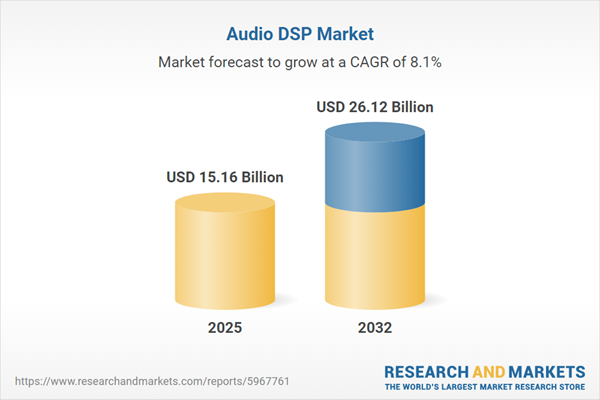Speak directly to the analyst to clarify any post sales queries you may have.
Senior executives seeking a strategic edge in the audio digital signal processor market must navigate rapid technological changes, intensifying regulatory demands, and complex integration requirements. Effective decisions rely on accurate, actionable intelligence that highlights evolving sector dynamics and supports resilient growth.
Market Snapshot: Current Trends in the Audio Digital Signal Processor Market
The global audio digital signal processor market is advancing as organizations across consumer electronics, automotive, telecommunications, healthcare, and defense seek enhanced audio quality and robust connectivity. Heightened expectations for seamless listening experiences, combined with the integration of technologies like 5G, are pushing manufacturers to adopt flexible audio DSP solutions. Mature and emerging markets alike are leveraging continuous innovation cycles to differentiate offerings, while changes in procurement and deployment strategies directly impact competitiveness and overall value delivered.
Scope & Segmentation of the Audio DSP Market
Clarity in market segmentation empowers leaders to direct digital signal processor investments towards optimal outcomes. The following segments drive differentiation and inform executive strategy:
- Product Types: Hardware digital signal processors offer board-level modules, dedicated units, and modular solutions for customizable integration. Software-based DSPs encompass plug-ins, firmware, and digital platforms that streamline technical workflows and support evolving operational needs.
- Applications: Aerospace and defense leverage DSPs for secure communications; the automotive sector focuses on noise reduction, safety, and advanced infotainment; healthcare applications center on diagnostic accuracy; consumer electronics emphasize expanded feature sets; and telecommunications enhance sophisticated voice-processing.
- Deployment Modes: Cloud-based options such as Platform as a Service and Software as a Service coexist with on-premises and embedded configurations, enabling organizations to balance control, scalability, and compliance requirements.
- End Users: Automotive component suppliers, consumer electronics manufacturers, original equipment manufacturers, and system integrators each demand tailored solutions, reflecting distinct technical standards and varied innovation cycles.
- Sales Channels: Enterprise sales, value-added resellers, technology partner integrations, and digital procurement platforms facilitate both transactional efficiency and collaborative engagement.
- Regions: Activity centers on North America, Europe, Asia-Pacific, the Middle East, and Africa. National priorities influence adoption, with regulatory and commercial factors varying across countries such as the United States, Canada, Brazil, United Kingdom, Germany, China, India, Japan, and Australia.
- Key Companies Profiled: Market leaders include Qualcomm Incorporated, Cirrus Logic Inc., Texas Instruments Incorporated, Analog Devices Inc., NXP Semiconductors N.V., MediaTek Inc., Samsung Electronics Co. Ltd., Realtek Semiconductor Corp., ESS Technology Inc., and XMOS Ltd.
Key Takeaways for Senior Decision-Makers
- Artificial intelligence and edge computing integration within audio DSP technology heighten responsiveness and analytical capability, strengthening efficiency across broad industry applications.
- Collaborative relationships among semiconductor, software, and hardware vendors accelerate market deployment and simplify interoperability, contributing to organizational agility.
- Strategic oversight of suppliers and channel partners increases flexibility and responsiveness, supporting adaptation to changing market conditions and minimizing exposure to disruption.
- Embracing cloud-based DSP architectures and open API frameworks enables more frequent feature rollouts and rapid alignment with evolving business objectives.
- Heightened attention to compliance and sustainability is influencing design, as ongoing advances in environmental and regulatory standards reshape organizational priorities.
- Developer-focused tools and frameworks streamline integration, empowering innovation and expediting responses to market shifts and client demands.
Tariff Impact: Navigating Evolving Cost Structures
Ongoing changes in US tariff regulations are prompting audio DSP manufacturers to review supply chain structures and sourcing methodologies. Shifting to system-on-chip and firmware-oriented architectures enables organizations to lessen hardware dependency and address exposure to fluctuating costs. Continuous risk assessment is now a critical factor for business agility and compliance in the broader regulatory landscape.
Methodology & Data Sources
This analysis draws from a balanced mix of expert interviews, comprehensive secondary research, and advanced data analytics. Methodologies include SWOT analysis, scenario planning, and geospatial modeling, ensuring executive decisions in the audio digital signal processor market are informed by actionable, proven insights.
Why This Report Matters
- Facilitates proactive executive responses to technological shifts and regulatory updates affecting audio DSP sector performance.
- Equips procurement and strategy leaders to accelerate digital transformation and better manage operational risk across diverse industry contexts.
- Delivers concise market intelligence to optimize competitive positioning and drive sustainable progress in priority regions.
Conclusion
Informed by comprehensive research, senior leaders are positioned to strengthen resilience and drive sustained growth as the audio DSP sector continues to evolve.
Additional Product Information:
- Purchase of this report includes 1 year online access with quarterly updates.
- This report can be updated on request. Please contact our Customer Experience team using the Ask a Question widget on our website.
Table of Contents
3. Executive Summary
4. Market Overview
7. Cumulative Impact of Artificial Intelligence 2025
Companies Mentioned
The companies profiled in this Audio DSP market report include:- Qualcomm Incorporated
- Cirrus Logic, Inc.
- Texas Instruments Incorporated
- Analog Devices, Inc.
- NXP Semiconductors N.V.
- MediaTek Inc.
- Samsung Electronics Co., Ltd.
- Realtek Semiconductor Corp.
- ESS Technology, Inc.
- XMOS Ltd.
Table Information
| Report Attribute | Details |
|---|---|
| No. of Pages | 189 |
| Published | October 2025 |
| Forecast Period | 2025 - 2032 |
| Estimated Market Value ( USD | $ 15.16 Billion |
| Forecasted Market Value ( USD | $ 26.12 Billion |
| Compound Annual Growth Rate | 8.0% |
| Regions Covered | Global |
| No. of Companies Mentioned | 11 |









